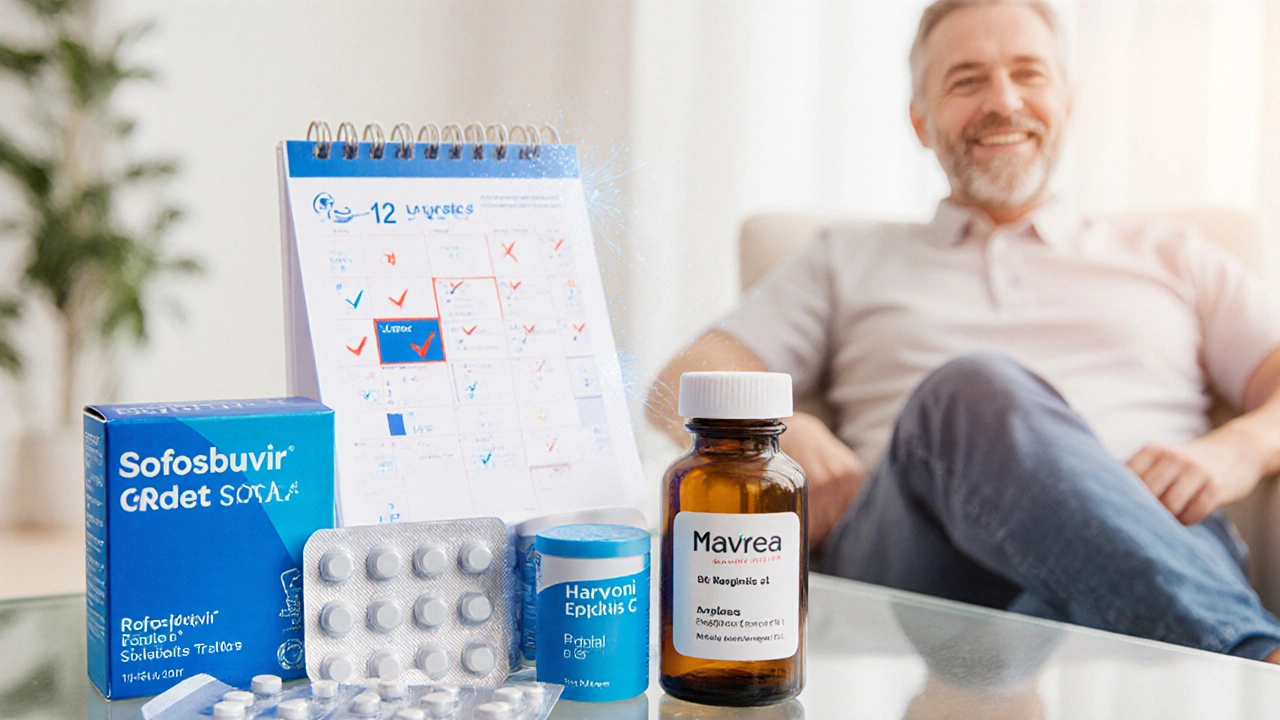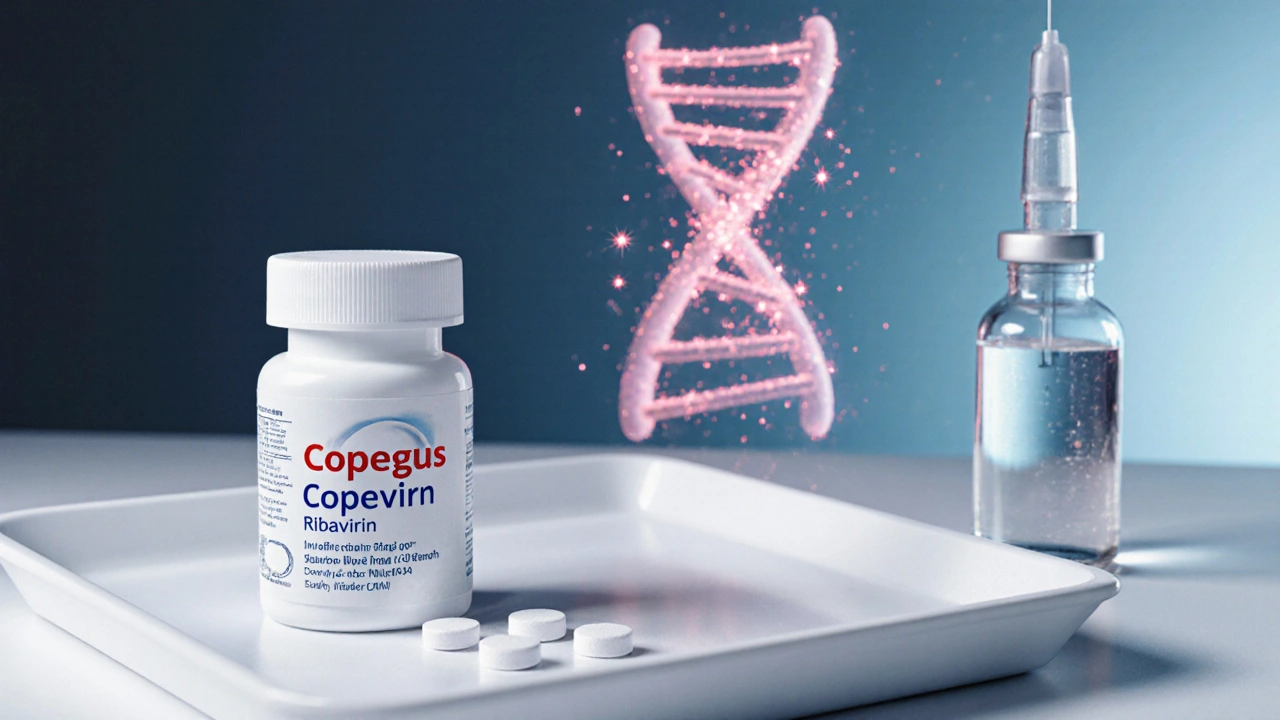Hepatitis C Treatment Regimen Comparison Tool
Treatment Comparison Results
Select regimen options and click Compare to see detailed analysis.
Comparison Table
| Regimen | Cure Rate | Duration | Side Effects | Cost Range |
|---|---|---|---|---|
| Copegus + Interferon | ~70% | 24 weeks | Hemolytic anemia, fatigue | $15,000-$20,000 |
| Sofosbuvir (Sovaldi) | ~95% | 12 weeks | Headache, fatigue | $30,000-$35,000 |
| Harvoni | ~98% | 8-12 weeks | Mild fatigue, headache | $35,000-$40,000 |
| Epclusa | ~99% | 12 weeks | Fatigue, insomnia | $33,000-$38,000 |
| Mavyret | ~99% | 8-12 weeks | Fatigue, bilirubin rise | $25,000-$30,000 |
If you or a loved one is battling hepatitisC, you’ve probably heard of Copegus. It’s an older antiviral that still shows up in treatment plans, but newer options promise higher cure rates with fewer side effects. This guide breaks down what Copegus actually does, how it stacks up against the most common alternatives, and what factors-like effectiveness, safety, and price-should guide your choice.
What is Copegus (Ribavirin)?
Copegus is the brand name for ribavirin, a synthetic nucleoside analogue that interferes with viral RNA synthesis. Approved by the U.S. Food and Drug Administration (FDA) in 1998, Copegus was originally paired with interferon‑alpha to treat chronic hepatitisC and some viral hemorrhagic fevers. It works by mimicking guanosine, getting incorporated into viral RNA, and causing lethal mutations that cripple the virus.
Ribavirin is a broad‑spectrum antiviral, meaning it’s active against several RNA viruses, but its real fame comes from hepatitisC regimens that pre‑date the direct‑acting antivirals (DAAs) that dominate today’s market.
Why Do Alternatives Exist?
The landscape of hepatitisC therapy changed dramatically after 2013 when DAAs hit the scene. These drugs target specific proteins of the hepatitisC virus (HCV), delivering cure rates (SVR12) above 95% with short, once‑daily dosing. In contrast, Copegus‑based regimens often required a lengthy 24‑week course, frequent injections, and a high pill burden.
Below are the five most widely used alternatives that have replaced or supplemented ribavirin in modern protocols:
- Sofosbuvir - a nucleotide analogue polymerase inhibitor that halts HCV replication.
- Ledipasvir - an NS5A inhibitor usually combined with sofosbuvir (Harvoni).
- Harvoni - the fixed‑dose combo of ledipasvir and sofosbuvir.
- Epclusa - a pan‑genotypic combo of sofosbuvir and velpatasvir.
- Mavyret - a combination of glecaprevir (NS3/4A protease inhibitor) and pibrentasvir (NS5A inhibitor).
Each of these agents targets a different step in the HCV lifecycle, allowing shorter, all‑oral regimens with cure rates that eclipse the ribavirin era.
How Copegus Works Compared to Direct‑Acting Antivirals
Copegus attacks the virus indirectly by inducing error‑prone replication, while DAAs lock onto viral enzymes or structural proteins. This fundamental difference shapes three practical outcomes:
- Speed of viral clearance - DAAs typically achieve undetectable viral loads within 2‑4 weeks; ribavirin alone can take months.
- Side‑effect profile - ribavirin is notorious for hemolytic anemia, teratogenic risk, and fatigue, whereas most DAAs have mild headache or fatigue.
- Treatment duration - modern regimens range from 8‑12 weeks, while Copegus‑based courses can stretch to 24 weeks.
Because of these gaps, clinicians now reserve ribavirin for specific niches-like genotype3 patients with cirrhosis who need an extra antiviral punch, or cases where resistance to DAAs is a concern.

Side‑Effect Snapshot: Copegus vs Alternatives
Understanding tolerability is crucial, especially for patients who must juggle other health issues. Here’s a quick look at the most common adverse events:
- Copegus: dose‑dependent hemolytic anemia (20‑30% of patients), teratogenicity (strict contraception required), insomnia, cough, and mood changes.
- Sofosbuvir: headache, fatigue, mild nausea; rare elevations in liver enzymes.
- Ledipasvir/Sofosbuvir (Harvoni): similar to sofosbuvir plus occasional rash; minimal anemia risk.
- Epclusa: fatigue, headache, insomnia; safe in patients with moderate renal impairment.
- Mavyret: headache, fatigue, rare bilirubin rise; approved for patients with advanced liver disease.
When anemia is a deal‑breaker, many clinicians now start a short ribavirin course only if a DAA alone is insufficient, and they monitor hemoglobin weekly.
Cost & Accessibility: What You’ll Actually Pay
Price often decides whether a regimen is feasible, especially in low‑resource settings. Below is a rough 2025 cost comparison (U.S. wholesale acquisition cost, per typical treatment course):
| Regimen | Mechanism | Treatment Length | Cure Rate (SVR12) | Typical Cost |
|---|---|---|---|---|
| Copegus + Interferon‑α | RNA mutagen + immune boost | 24weeks | ~70% | $15,000‑$20,000 |
| Sofosbuvir (Sovaldi) | NS5B polymerase inhibitor | 12weeks | ~95% | $30,000‑$35,000 |
| Harvoni (Ledipasvir/Sofosbuvir) | NS5A + NS5B inhibition | 8‑12weeks | ~98% | $35,000‑$40,000 |
| Epclusa (Sofosbuvir/Velpatasvir) | Pan‑genotypic NS5B + NS5A | 12weeks | ~99% | $33,000‑$38,000 |
| Mavyret (Glecaprevir/Pibrentasvir) | NS3/4A protease + NS5A inhibition | 8‑12weeks | ~99% | $25,000‑$30,000 |
While ribavirin itself is cheap (under $500 for a full course), the need for interferon injections and longer duration pushes the total cost up. In contrast, all‑oral DAAs eliminate injections, cut monitoring visits, and often qualify for insurance pre‑authorization, making the higher pill price worthwhile.
When Might Copegus Still Be the Right Choice?
Even with powerful DAAs, ribavirin has niche indications where it adds value:
- Genotype3 with advanced fibrosis - several studies (e.g., AASLD 2021) showed ribavirin boosted SVR12 when added to sofosbuvir‑based regimens.
- Patients with prior DAA failure - ribavirin can be combined with newer protease inhibitors to overcome resistance.
- Resource‑limited settings - if DAAs are unavailable, a ribavirin‑interferon combo remains a WHO‑endorsed option.
In each scenario, clinicians must weigh the anemia risk against the potential increase in cure probability.
Decision‑Making Checklist: Picking the Best Regimen
Use this quick checklist during a consultation. Tick the boxes that apply, then discuss the resulting recommendation with your healthcare provider.
- What is the patient’s HCV genotype?
- Is there cirrhosis or advanced fibrosis (stageF3/F4)?
- Are there any drug‑interaction concerns (e.g., HIV meds, immunosuppressants)?
- Does the patient have a history of anemia or heart disease?
- What is the patient’s insurance coverage or out‑of‑pocket budget?
- Is there access to a specialty pharmacy for injectable interferon?
Answering these questions usually points to a pan‑genotypic DAA (Epclusa or Mavyret) for most adults. If genotype3 cirrhosis is present, the checklist may tip the scale toward adding ribavirin to a sofosbuvir‑based backbone.

Practical Tips for Managing Ribavirin‑Induced Anemia
If ribavirin ends up in the regimen, here’s how to keep the side‑effects under control:
- Baseline CBC and reticulocyte count before starting therapy.
- Monitor hemoglobin every 2weeks for the first 8weeks, then monthly.
- Reduce ribavirin dose by 200mg increments if hemoglobin drops below 10g/dL.
- Consider erythropoietin‑stimulating agents for severe anemia, but only under specialist supervision.
- Provide iron‑rich diet advice and supplement only if iron‑deficiency is documented.
These steps often allow patients to finish treatment without needing a full drug discontinuation.
Future Outlook: Is Ribavirin Heading for Obsolescence?
Industry pipelines suggest that next‑generation DAAs will solidify pan‑genotypic cures with 4‑week courses, rendering ribavirin a relic for most patients. However, the drug’s low manufacturing cost and established safety data keep it on WHO’s essential medicines list for low‑income countries. Expect it to linger in guidelines for niche cases at least through the next decade.
Key Takeaways
- Copegus (ribavirin) works by mutating viral RNA and needs interferon for optimal efficacy.
- Modern DAAs (sofosbuvir‑based combos, Mavyret) achieve >95% cure rates in 8‑12weeks with far fewer side effects.
- Ribavirin’s main drawbacks are anemia, teratogenic risk, and long treatment length.
- Cost‑wise, ribavirin itself is cheap, but the full regimen can be pricey due to injections and monitoring.
- Use ribavirin only for specific genotypes, prior DAA failures, or in settings where DAAs are unavailable.
Frequently Asked Questions
Can I take Copegus without interferon?
Ribavirin alone has modest antiviral activity against HCV and is rarely used as monotherapy. In most approved regimens, it must be paired with interferon‑alpha or a potent DAA to achieve meaningful cure rates.
Is ribavirin safe for pregnant women?
No. Ribavirin is classified as Pregnancy Category X because it can cause severe birth defects. Both men and women must use reliable contraception during treatment and for six months after the last dose.
How does the cure rate of Copegus compare to Harvoni?
When paired with interferon, Copegus‑based regimens achieve roughly 70% sustained virologic response (SVR12). Harvoni, a fixed‑dose combination of ledipasvir and sofosbuvir, delivers about 98% SVR12 in the same patient populations, making it far more reliable.
What monitoring is required for ribavirin‑induced anemia?
Baseline complete blood count (CBC) should be done before therapy. Hemoglobin is then checked every two weeks for the first eight weeks, followed by monthly checks. If levels fall below 10g/dL, dose reduction or temporary discontinuation is recommended.
Are there any generic versions of Copegus?
Yes. Several manufacturers produce generic ribavirin tablets that cost a fraction of the branded Copegus price. However, insurance formularies often still require the brand name for reimbursement, so patients should verify coverage before switching.


Alissa DeRouchie
October 8, 2025 AT 19:11Ribavirin still? Wow.
George Frengos
October 15, 2025 AT 00:31The advent of direct‑acting antivirals has truly transformed hepatitis C therapy. With cure rates north of 95 % and treatment courses as short as eight weeks, patients can avoid the burdensome interferon injections that made older regimens like Copegus so challenging. Moreover, the side‑effect profile of modern combos such as Harvoni or Mavyret is comparatively mild, often limited to transient headache or fatigue. From a clinical perspective, these newer options also simplify monitoring, reducing the need for frequent labs and specialist visits.
Jonathan S
October 21, 2025 AT 05:51It is ethically indefensible to continue prescribing a regimen that leaves a substantial proportion of patients behind, especially when the evidence base clearly demonstrates superior outcomes with newer agents. The moral calculus must weigh the 30 % treatment failures of ribavirin‑based protocols against the near‑certainty of success offered by pan‑genotypic DAAs. Patients deserve therapies that minimize harm; hemolytic anemia and teratogenic risk are not trivial side‑effects to be brushed aside as "manageable" 🙅♂️. Moreover, the economic argument that ribavirin is cheap ignores the hidden costs of additional clinic visits, laboratory monitoring, and the societal burden of prolonged illness. Insurance frameworks that still reimburse interferon‑based courses perpetuate outdated practices and undermine public health goals. The scientific community has a duty to phase out antiquated regimens in favor of evidence‑based, patient‑centered care. Continuing to offer Copegus in settings where DAAs are available is tantamount to rationing quality care based on inertia rather than data. While resource‑limited regions may lack immediate access to the latest drugs, global health initiatives and generic DAA productions are rapidly closing that gap, making the excuse of "cost" increasingly untenable. 🌍💊 The ethical imperative is clear: prioritize treatments with the highest efficacy, lowest toxicity, and shortest duration, and relegate ribavirin to a truly niche, last‑resort role. In doing so we honor the principle of non‑maleficence and uphold the trust patients place in their clinicians. Let us not hide behind outdated protocols when better options stand ready for deployment.
Charles Markley
October 27, 2025 AT 11:11From a pharmacodynamic perspective, the ribavirin‑interferon tandem represents a relic of a bygone era dominated by suboptimal viral suppression mechanisms. The lack of target specificity results in a cascade of off‑target hematologic perturbations, notably hemolytic anemia, which complicates therapeutic adherence. In contrast, the mechanistic elegance of NS5A inhibitors and protease inhibitors offers a synergistic blockade of viral replication, thereby truncating the treatment window to a mere 8–12 weeks. Economically, the marginal cost savings of ribavirin are eclipsed by the cumulative expense of ancillary care-frequent CBC monitoring, dose adjustments, and potential transfusions. Clinicians must therefore adopt a lexicon that privileges high‑fidelity regimens over antiquated, low‑resolution approaches.
L Taylor
November 2, 2025 AT 16:31Cost‑effectiveness should be evaluated holistically; the upfront price of a pan‑genotypic DAA may appear steep, yet it obviates the downstream expenditures associated with anemia management, prolonged therapy, and lost productivity. Philosophically, investing in a cure that restores health swiftly aligns with the broader societal imperative of minimizing disease burden.
Matt Thomas
November 8, 2025 AT 21:51Ribavirin is just cheap old school but its side effects r nasty and it takes forever to finish.
Nancy Chen
November 15, 2025 AT 03:11Ever notice how the big pharma giants push the newest, most expensive drugs while keeping older, cheaper options on the shelf just enough to keep them in the narrative? It feels like a deliberate strategy to keep patients dependent on a cycle of ever‑rising costs, especially when those legacy drugs still work for a subset of folks. The hidden agenda is all about profit margins, not patient outcomes.
Becky B
November 21, 2025 AT 08:31From an American perspective, we should demand transparency from pharmaceutical companies so that all patients, regardless of income, can access the most effective treatments without being forced into outdated regimens that compromise health.
Marcus Edström
November 27, 2025 AT 13:51When choosing a regimen, start by confirming the genotype, assessing liver fibrosis stage, checking for comorbidities like anemia, and reviewing insurance coverage. If the patient meets criteria for a pan‑genotypic DAA, those options usually simplify the course and improve adherence. For those rare cases where ribavirin adds value, close hematologic monitoring is essential.
kevin muhekyi
December 3, 2025 AT 19:11Good summary, thanks for the checklist.